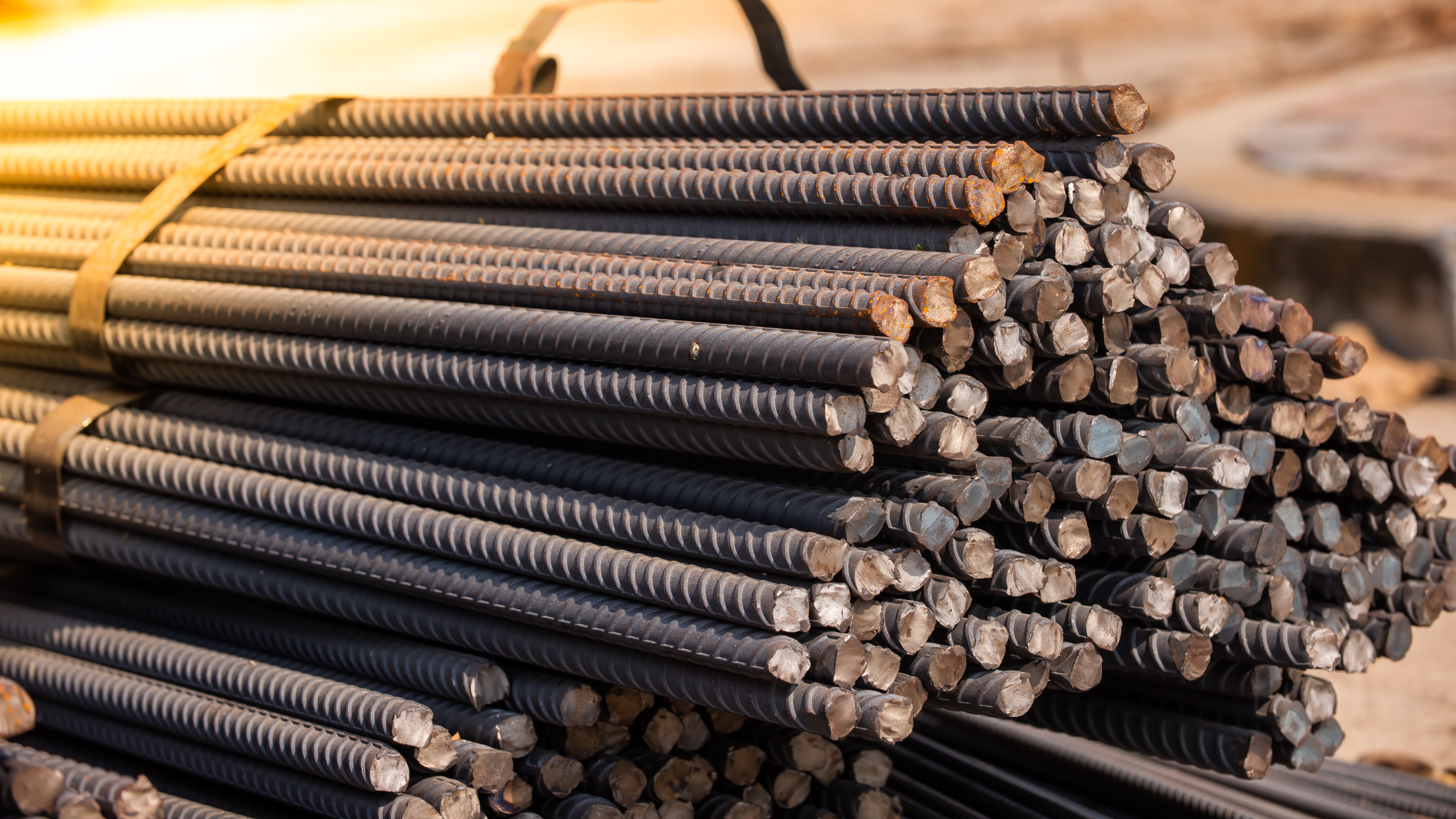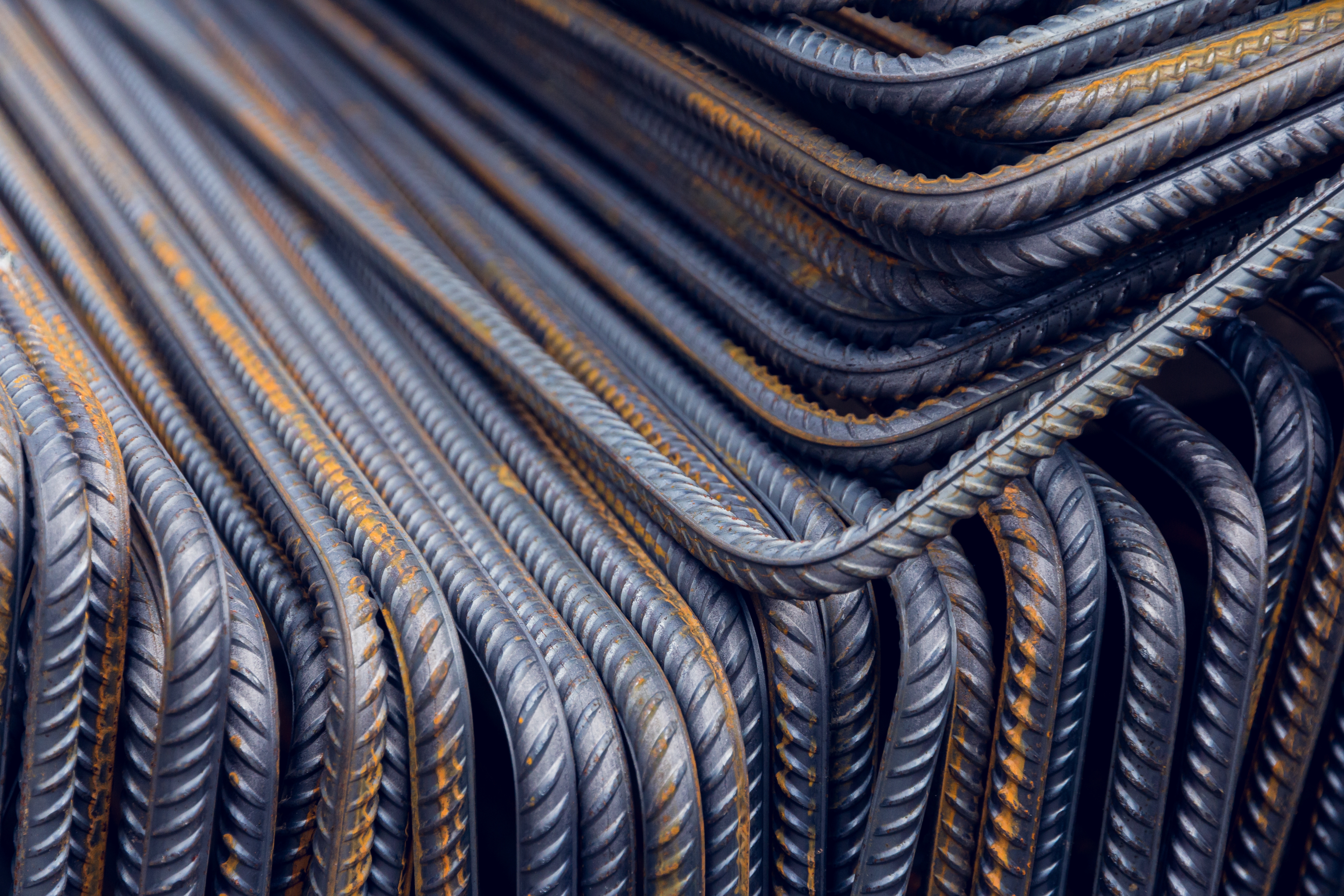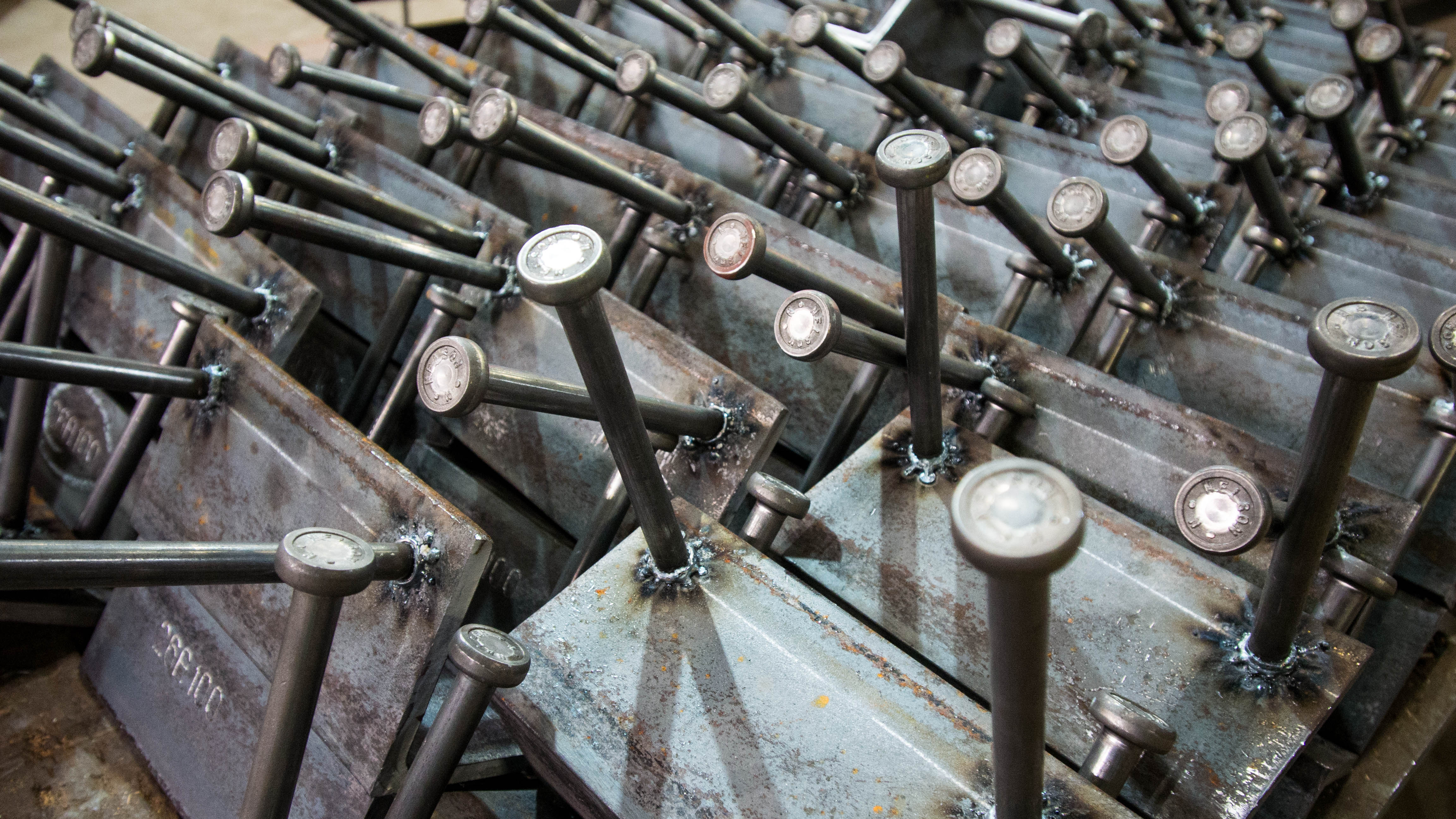Rebar, Embeds and Weld Studs

1. Rebar (Reinforcing Bar): Rebar, short for reinforcing bar, is a critical component in reinforced concrete and masonry structures. It's typically made from carbon steel and features ridges or deformations along its length to improve adhesion to the concrete. Here are some key points about rebar:
- Purpose: Rebar provides tensile strength to reinforced concrete structures, which are inherently strong in compression but weak in tension. It helps prevent cracks and enhances the structural integrity of concrete elements.
- Types: Rebar comes in various shapes, sizes, and grades. Common types include plain round bars and deformed bars, with the latter offering better adhesion properties due to their surface irregularities.
- Applications: Rebar is extensively used in construction projects such as buildings, bridges, highways, dams, and other structures requiring reinforced concrete. It's typically placed in concrete forms before pouring and is arranged according to engineering specifications.
- Installation: Rebar is placed and secured within concrete forms using supports, spacers, and tie wires to ensure proper positioning and alignment. It's crucial to adhere to construction codes and standards during installation to maintain structural integrity.
2. Embeds: Embeds, also known as concrete embeds or concrete inserts, are prefabricated metal components embedded within concrete structures to provide attachment points for fixtures, equipment, or other structural elements. Here's what you need to know about embeds:
- Types: Embeds come in various shapes and configurations, including threaded rods, plates, hooks, loops, and anchors. They may have welded or threaded connections for attaching other components.
- Materials: Embeds are typically made from carbon steel, stainless steel, or other alloys with sufficient strength and corrosion resistance for their intended applications.
- Applications: Embeds are used in a wide range of construction projects to facilitate the attachment of mechanical, electrical, plumbing, and architectural components to concrete structures. Common applications include anchor bolts for securing equipment, lifting inserts for handling precast concrete elements, and threaded inserts for mounting fixtures.
3. Weld Studs: Weld studs, also known as welding studs or stud bolts, are fasteners used in welding applications to create permanent joints between a stud and a workpiece. These studs are welded onto a base material to provide a secure attachment point for various components, fixtures, or structures. Here's what you need to know about weld studs:
- Types: Weld studs come in various types, including threaded studs, unthreaded studs, flanged studs, and stud anchors, each designed for specific welding applications and structural requirements.
- Materials: Weld studs are typically made from carbon steel, stainless steel, or alloy steel, with surface coatings or platings for corrosion resistance or improved weldability.
- Applications: Weld studs are used in a wide range of industries, including construction, manufacturing, automotive, aerospace, and shipbuilding, for attaching components such as brackets, supports, fasteners, and structural elements.
- Installation: Weld studs are welded onto the surface of a workpiece using various welding processes, including arc welding, resistance welding, and friction welding. The welding process involves heating the base material and the stud to a molten state and then applying pressure to create a fusion weld between the two surfaces.
In summary, rebar, embeds, and weld studs are essential components in construction and manufacturing, providing structural reinforcement, attachment points, and fastening solutions for a wide range of applications. Proper selection, installation, and quality control are crucial to ensuring the safety, integrity, and performance of concrete structures and welded assemblies.
REBAR
Rebar, short for reinforcing bar, is a critical component in reinforced concrete and masonry structures. Comprising steel bars or mesh, rebar reinforces concrete to withstand tension forces.
Composition: Rebar is typically made from carbon steel, sometimes alloy steel. Carbon steel rebar is the most common due to its cost-effectiveness and general applicability. However, in corrosive environments or for specialized applications, stainless steel or epoxy-coated rebar may be used to enhance durability.
Manufacturing: Rebar is manufactured through a process called hot rolling. Steel billets are heated to a high temperature and then passed through rollers to form the desired shape, typically a cylindrical bar with deformations or ridges along its length to improve bonding with concrete
- Types of Rebar:
- Deformed Rebar: This type of rebar features deformations or ridges along its surface, enhancing the bond between the steel and concrete. Deformed rebar provides better anchorage and resistance to slippage within the concrete.
- Plain Rebar: Plain rebar lacks the deformations of deformed rebar and is primarily used in applications where the bond between the concrete and steel is not a significant concern, such as in pavements and slabs.
- Grades of Rebar:
- Grade 40: This is the lowest grade of rebar and is typically used in light construction projects or for temporary structures where strength requirements are minimal.
- Grade 60: Grade 60 rebar is the most commonly used grade and offers a balance of strength and cost-effectiveness suitable for a wide range of applications.
- Grade 75: Grade 75 rebar provides higher strength compared to Grade 60 and is often used in more demanding structural applications or where higher loads are anticipated.
- Applications:
- Construction: Rebar is extensively used in construction projects such as buildings, bridges, highways, dams, and other structures requiring reinforced concrete. It adds tensile strength to concrete, allowing it to withstand forces such as tension and bending.
- Infrastructure: Rebar is a crucial component in infrastructure projects, reinforcing concrete elements such as columns, beams, slabs, and foundations to ensure structural integrity and durability.
- Industrial: In industrial settings, rebar is used in various applications such as retaining walls, storage tanks, and industrial floors where reinforced concrete is necessary for load-bearing capacity and resistance to environmental factors.
- Advantages:
- Enhanced Strength: Rebar significantly improves the tensile strength and load-bearing capacity of concrete structures, making them more resilient to forces like bending and tension.
- Durability: Rebar enhances the durability and longevity of concrete structures, reducing the risk of cracking, deformation, and structural failure over time.
- Cost-Effectiveness: Rebar is a cost-effective solution for reinforcing concrete compared to alternative methods, offering a balance of performance and affordability.
- Versatility: Rebar comes in various sizes, grades, and configurations, allowing it to be tailored to specific project requirements and structural designs.
Rebar plays a fundamental role in the construction industry, providing essential reinforcement for concrete structures and ensuring their strength, stability, and longevity. Whether in skyscrapers, bridges, or residential buildings, rebar is a cornerstone of modern construction practices.
STEEL EMBEDS
Steel embeds, also known as embedment plates or embedded steel plates, are structural elements used to connect and anchor various components within concrete structures. These steel plates or bars are placed or cast into concrete during its pouring or construction phase, allowing for secure attachment of other structural elements or fixtures. Here's an overview of steel embeds:
Composition: Steel embeds are typically made from carbon steel, alloy steel, or stainless steel, depending on the requirements of the specific application. Carbon steel embeds are the most common due to their affordability and general applicability. However, stainless steel embeds may be used in corrosive environments or where enhanced durability is needed.
- Types of Steel Embeds:
- Plate Embeds: Plate embeds are flat steel plates with pre-drilled holes or welded studs designed for anchoring purposes. They are often used to secure structural steel components, equipment, or machinery to concrete foundations or walls.
- Bar Embeds: Bar embeds consist of steel bars or rods embedded into concrete to provide reinforcement or anchorage. They can be straight or bent, depending on the application requirements, and are commonly used in reinforced concrete construction to connect structural elements or provide additional support.
- Anchors: Steel anchors are specialized embeds designed to provide secure attachment points for items such as handrails, guardrails, machinery, or equipment. They come in various configurations, including threaded studs, expansion anchors, and hooked anchors, and are cast or embedded into concrete during construction.
- Installation:
- Steel embeds are typically installed during the concrete pouring process. They are placed in the desired location within the concrete formwork before the concrete is poured.
- For plate embeds, anchor bolts or studs are often cast into the concrete, ensuring a secure attachment point for subsequent structural elements or fixtures.
- Bar embeds are positioned according to engineering specifications and may be spaced at specific intervals to provide reinforcement or anchorage as required.
- Applications:
- Structural Connections: Steel embeds are commonly used to connect structural steel components, such as columns, beams, and bracing, to concrete foundations or walls in building and bridge construction.
- Equipment Mounting: Plate embeds are used to anchor heavy equipment, machinery, or mechanical components to concrete floors or pads in industrial settings, warehouses, and manufacturing facilities.
- Anchoring Fixtures: Steel anchors provide secure attachment points for items such as handrails, guardrails, signage, lighting fixtures, and machinery in various construction and infrastructure projects.
- Advantages:
- Strength and Durability: Steel embeds provide strong and durable anchorage points within concrete structures, ensuring stability and reliability over time.
- Versatility: Steel embeds come in various shapes, sizes, and configurations to accommodate a wide range of applications and attachment requirements.
- Customization: Steel embeds can be customized to meet specific project specifications and engineering requirements, ensuring optimal performance and safety.
- Cost-Effectiveness: Steel embeds offer a cost-effective solution for securing structural components, equipment, and fixtures to concrete compared to alternative methods.
Steel embeds are essential components in concrete construction, providing secure attachment points and reinforcement for structural elements, equipment, and fixtures. Their strength, durability, and versatility make them indispensable in a variety of construction and industrial applications.
↵
WELD STUDS
Weld studs, also known as welding studs or stud bolts, are fasteners used in welding applications to create permanent joints between a stud and a workpiece. These studs are welded onto a base material to provide a secure attachment point for various components, fixtures, or structures. Here's a breakdown of weld studs:
Composition:
- Weld studs are typically made from low carbon steel, stainless steel, or other alloyed materials suitable for welding applications. The choice of material depends on factors such as the mechanical properties required, corrosion resistance, and environmental conditions.
- Some weld studs may also have surface coatings or plating, such as zinc, galvanized, or ceramic coatings, to enhance corrosion resistance or improve weldability.
Types of Weld Studs:
- Headed Concrete Anchor
- Shear Connectors
- Deformed Bar Anchor
- Punching Shear Resistor
- Full Thread Stud
- Partial Thread Stud
- Reduced Base Stud
- Collar Stud
- No Thread Stud
- Tapped Stud
- Rectangular Stud
- Capacitor Discharge Stud
- Insulation Stud
Welding Process:
- Weld studs are welded onto the surface of a workpiece using a variety of welding processes, including arc welding (such as stud arc welding or capacitor discharge welding), resistance welding (such as drawn arc stud welding or short cycle welding), and friction welding.
- The welding process involves heating the base material and the stud to a molten state and then applying pressure to create a fusion weld between the two surfaces. The weld must be strong and durable to withstand mechanical loads and environmental conditions.
Applications:
- Weld studs are widely used in construction, manufacturing, and fabrication industries for various applications, including:
- Structural steel fabrication: Attaching beams, columns, and other structural components.
- Automotive industry: Attaching brackets, supports, and other components.
- Shipbuilding: Securing panels, frames, and deck structures.
- Machinery and equipment: Mounting motors, pumps, and other machinery components.
- Electrical and electronics: Attaching grounding lugs, cable trays, and enclosures.
- Aerospace: Attaching panels, insulation, and components in aircraft and spacecraft.
Advantages:
- Efficiency: Weld studs provide a quick and efficient method for attaching components, reducing assembly time and labor costs.
- Strength: Welded joints between studs and workpieces typically have high strength and durability, providing reliable performance in demanding applications.
- Versatility: Weld studs come in various sizes, shapes, and configurations to meet different application requirements, offering flexibility in design and assembly.
- Accessibility: Weld studs can be welded onto surfaces that may be difficult to access with traditional fastening methods, such as nuts and bolts.
In summary, weld studs are essential components in welding applications, providing a convenient and reliable means of attaching components, structures, and fixtures in various industries. Their versatility, strength, and efficiency make them indispensable for creating durable and secure weld joints in a wide range of applications.


